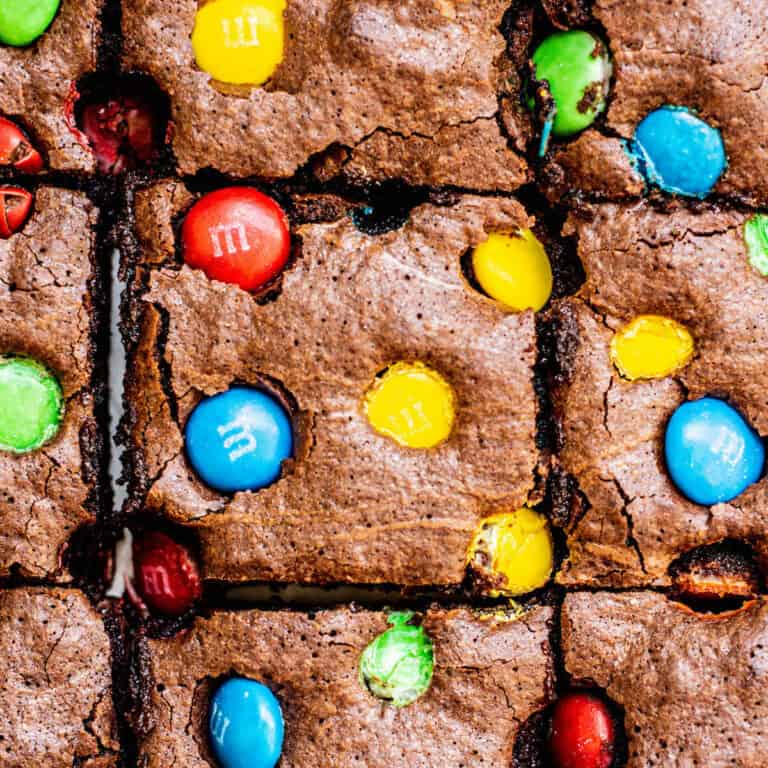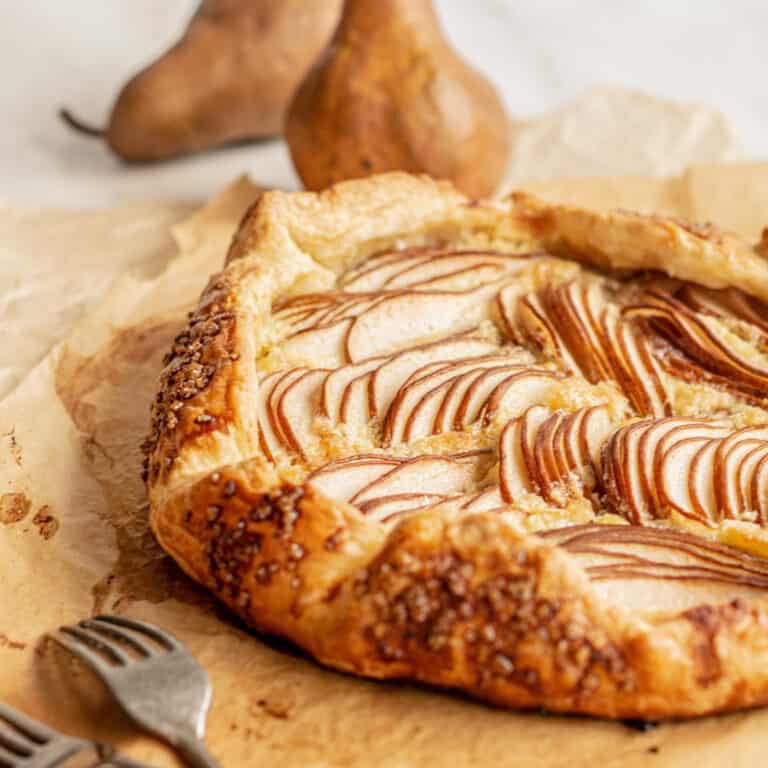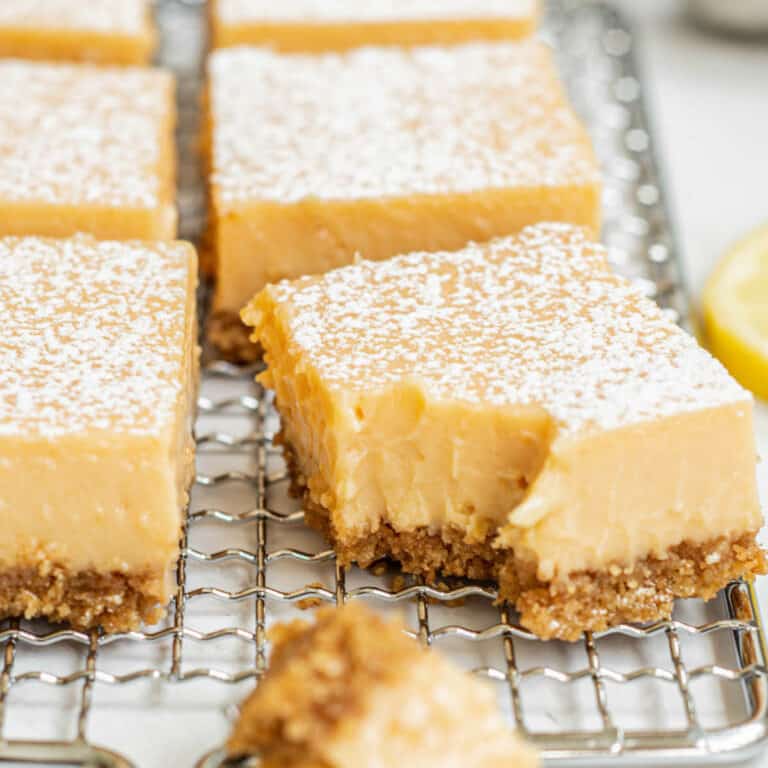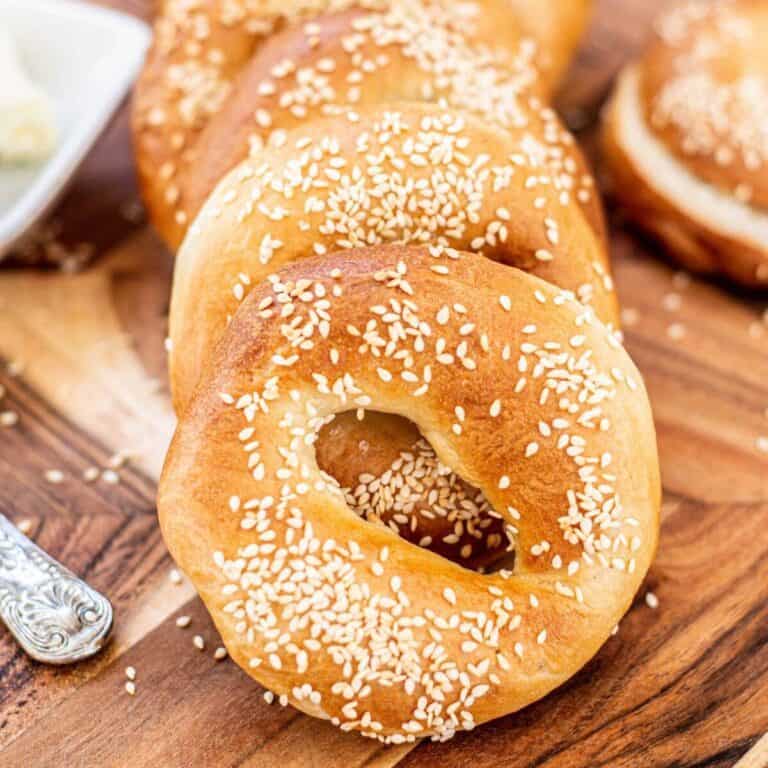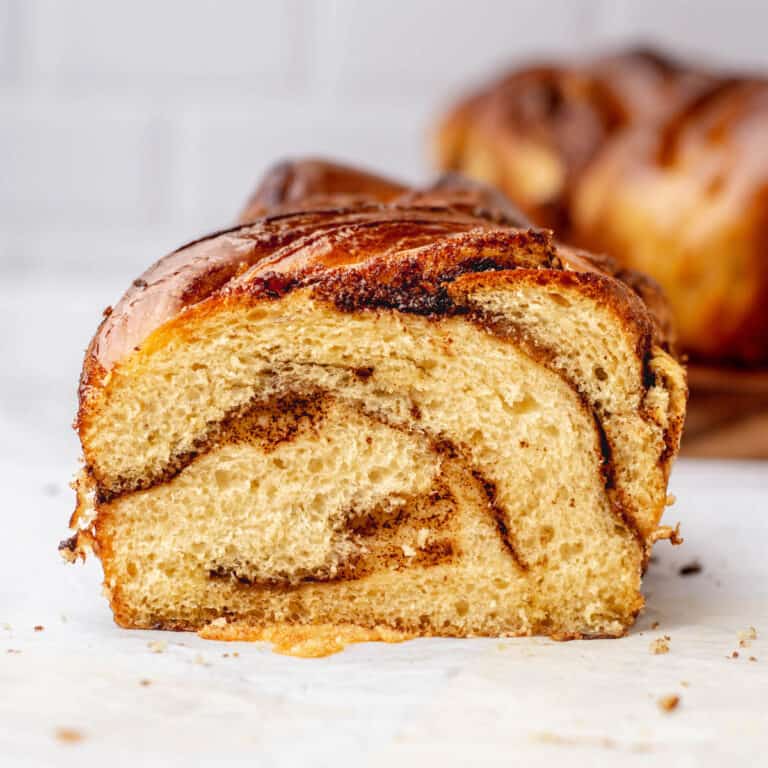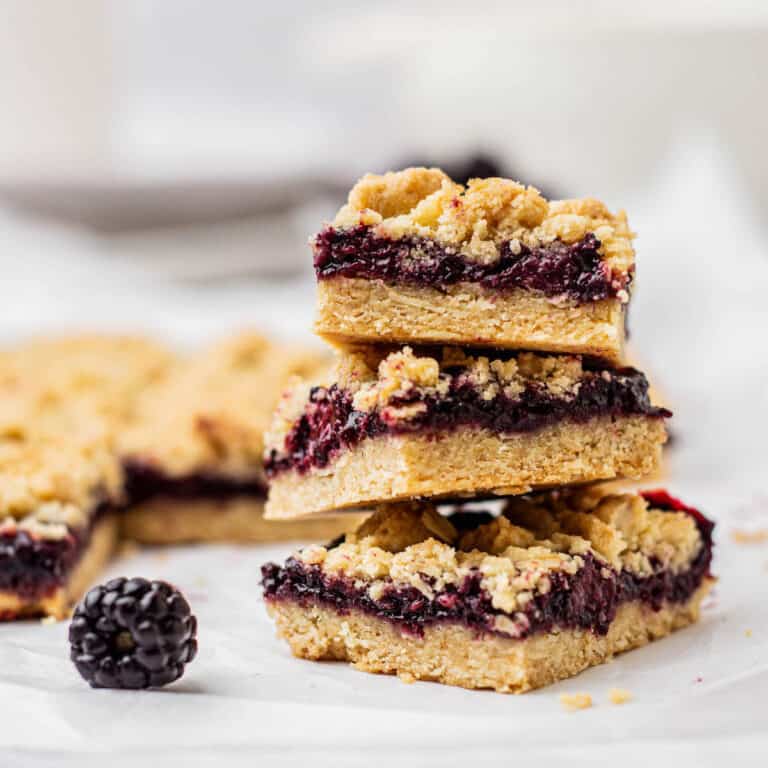Inverted Puff Pastry – Step by Step
Learn to make inverted puff pastry for the flakiest, best-tasting homemade pastry! Inverted puff pastry is super flaky and full of layers. In traditional puff pastry, the butter is encased inside the dough. In inverted puff pastry, the dough is encased inside the butter.
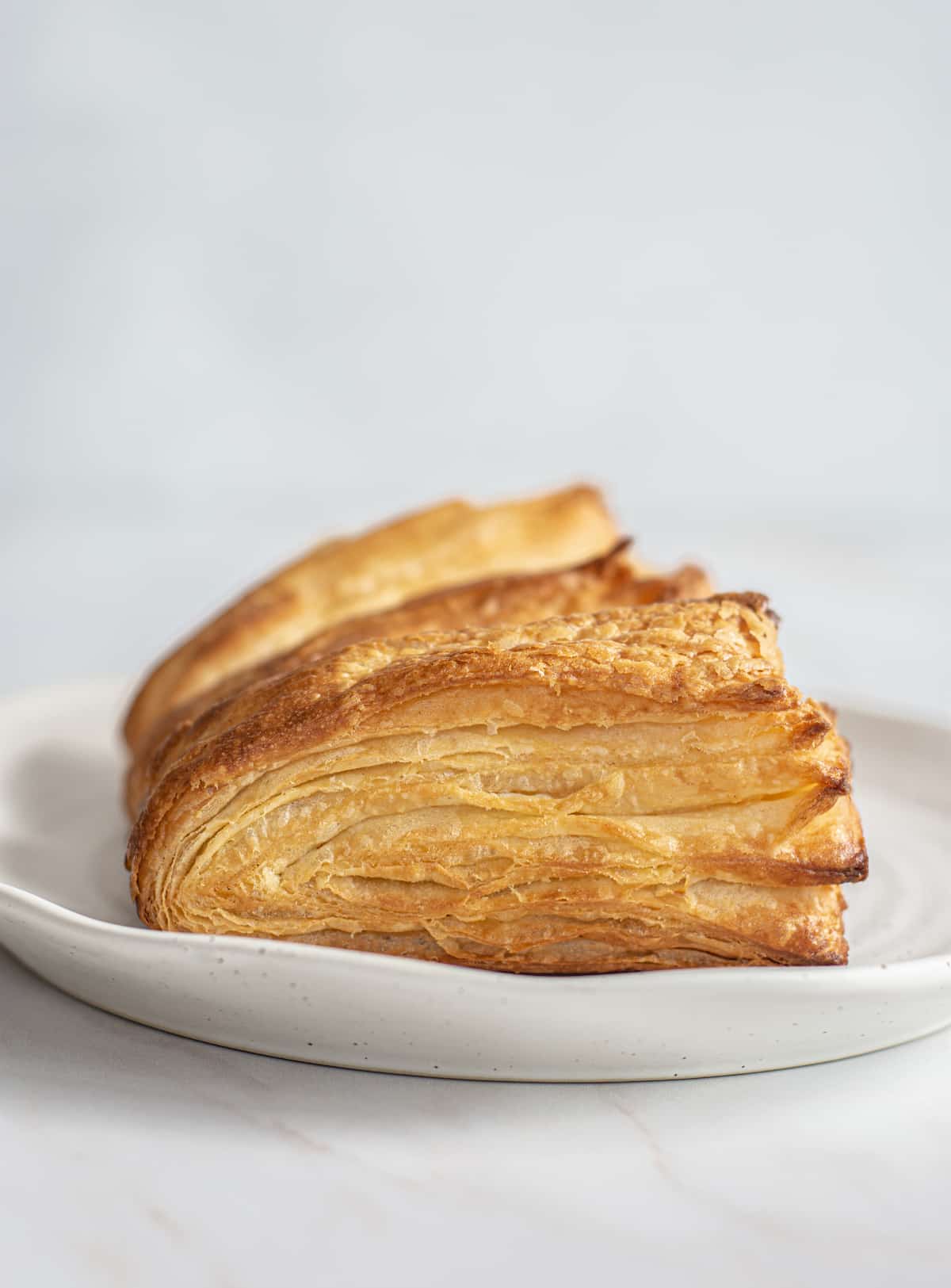
Encasing the butter around the dough creates an even lighter pastry than a regular puff pastry. It’s a labor of love making it, but it’s worth the result. This recipe makes enough to freeze for multiple dishes. If you’re short on time, try this flaky rough puff pastry instead!
How long does puff pastry take to make?
Puff pastry needs time for the butter to be laminated into the dough and for the dough to relax and for the butter to stay cool in between laminating. This puff pastry recipe needs a minimum of 7 hours from start to finish.
If you have more time than this, the chilling time in between folds can be extended, and your puff pastry will be even better. Puff pastry relies on the butter to stay cool between the layers, so it must have enough refrigerator time, and the butter must never melt.
In total, the puff pastry is folded 6 times, with a fridge rest in between every 2 folds.
Puff pastry components
Puff pastry is a French pastry made from 2 components – the beurrage and the détrempe.
- The beurrage is the butter packet which is made up of predominantly butter, with a bit of flour for easier rolling.
- The détrempe is the name for the dough mixture which is encased by the butter.
The butter/dough is rolled out multiple times and chilled in between to create layers of cold butter in between the dough. Later when the pastry is baked, the water in the butter will evaporate and cause the layers to puff up.
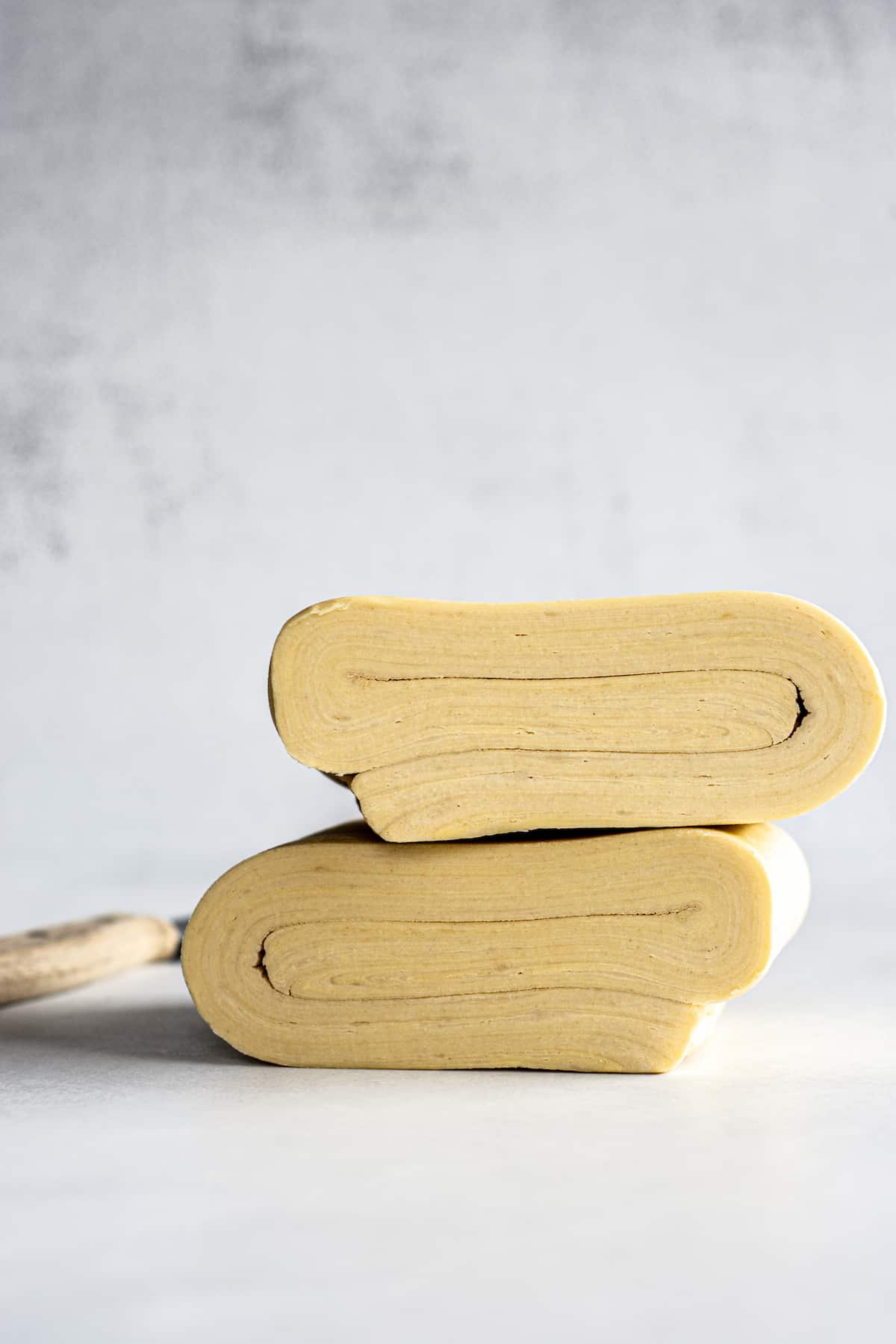
The ingredients
Here is what you need for inverted puff pastry
- Unsalted butter – The butter doesn’t need to be fancy. It just needs to have at least 80% butterfat. You can also use salted butter, though the salt in the main dough may need reducing.
- All-purpose flour or pastry flour
- Sugar – Only a small amount to balance flavors
- Salt – For flavor
- Water – To create the dough
- Vinegar – a little acid helps to create a more tender pastry. Substitute it for lemon juice if you have no vinegar.
Baker’s schedule
- 9 am – Create the dough and chill for 2 hours
- 10:30 am – Mix the butter packet and chill for around 20-30 minutes.
- 11:00 am Roll out the butter to about double the size of the dough. Encase the dough in the butter. Roll out lengthwise and perform a book fold (Pictured in the step-by-step instructions below). Turn the dough and book fold again. Chill for a minimum of 1 hour.
- 12:30 pm – Roll out lengthwise and perform a book fold. Turn the dough and book fold again. Chill for a minimum of 1 hour.
- 2:00 pm – Roll out lengthwise and perform a book fold. Turn the dough and book fold again. Chill for a minimum of 2 hours.
- 4:00 pm – Portion up the puff pastry and use it or freeze it.
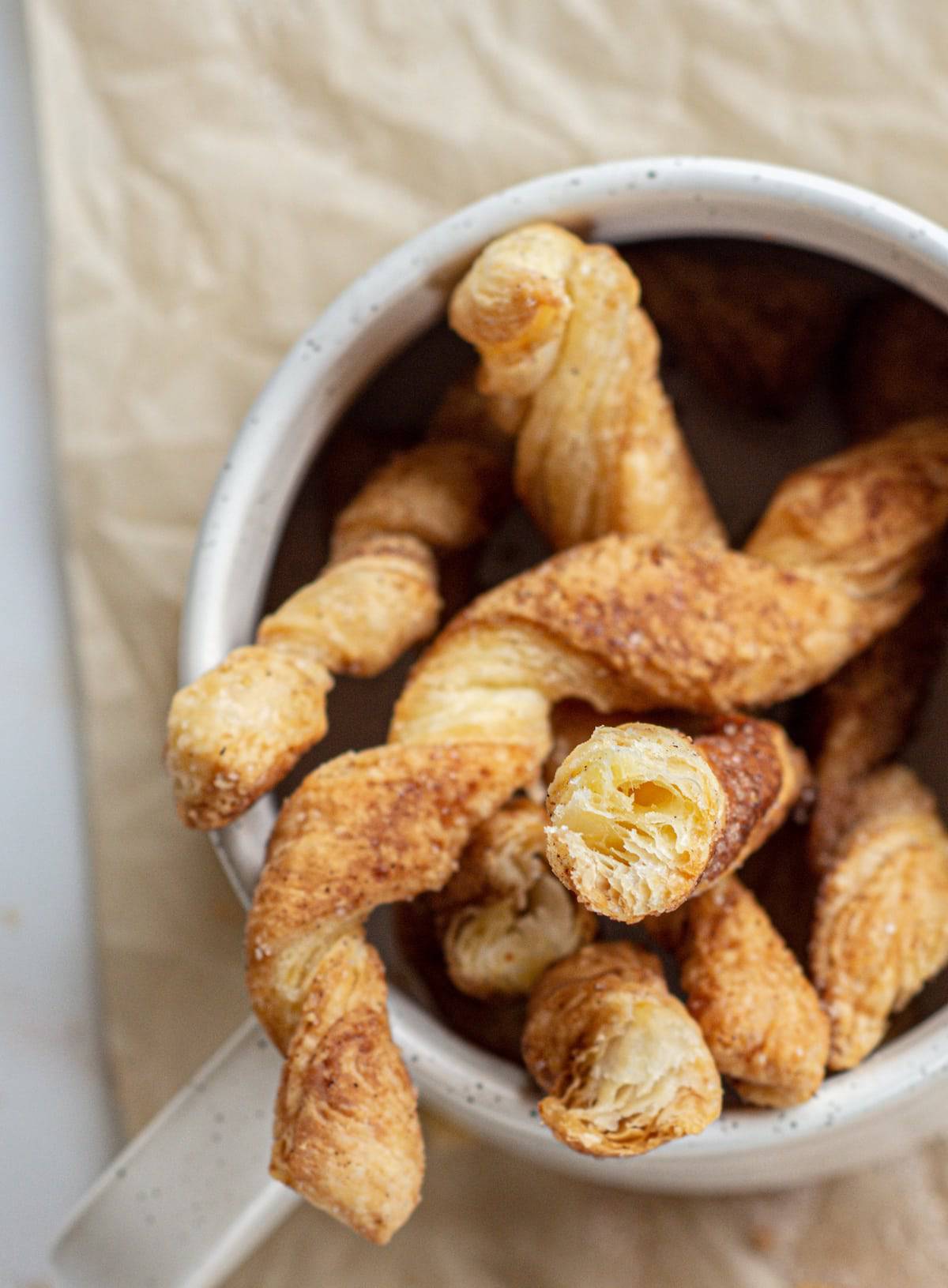
Step by step instructions
Make the dough first as it needs a bit of chilling time to relax the gluten and make it easier to roll out.
The dough
- Firstly, in a large bowl mix together the flour, water, butter, sugar, and salt into a rough dough. Secondly, tip the dough out onto a floured bench and knead it for around 5 minutes until smooth.
- Shape the dough into a 7x7inch (18x18cm) square. Wrap it up in parchment paper, cling wrap or place it in an airtight container and refrigerate it for 2 hours.
The butter packet
- Firstly, mix together the room temperature butter and flour for the butter block until well incorporated. Secondly, spread the butter in between two sheets of parchment paper and roll it out into a 7x7inch (18x18cm) square.
- Chill this butter for around 20 minutes until cool but still pliable. If chilling for longer than this, remove the butter 10 minutes before the dough to ensure it’s not too hard.
The butter and the dough need to be similar consistencies. If the butter is too hard it will crack and shatter, and if it is too soft it will melt.
Laminating
- Remove the butter packet from the fridge and place it on a well-floured bench. Roll the butter out into a 14x8inch (36x20cm) rectangle. Use as much flour as you need to stop the butter from sticking to the rolling pin or the bench. Lift the butter up regularly as you roll it to ensure it isn’t sticking to the bench.
- Place the dough at the bottom of the butter rectangle and fold the top of the butter over so it encases the dough.
Folds 1 & 2
- Roll the butter+dough out into a rectangle that’s about 18×9 inches (45×22 cm). Focus on lengthening it, not widening it. Use dustings of flour as you need to, to ensure it rolls smoothly without sticking.
- Once it’s in a rectangle, dust off any excess flour. Fold the top third of the rectangle down to the middle. Bring the bottom third over top. That was fold 1.
- Turn the dough 90 degrees and roll it back out into an 18×9 inches (45×22 cm) rectangle and repeat the fold. That was fold 2.
- Wrap the dough up tightly and chill in the fridge for a minimum of 1 hour.
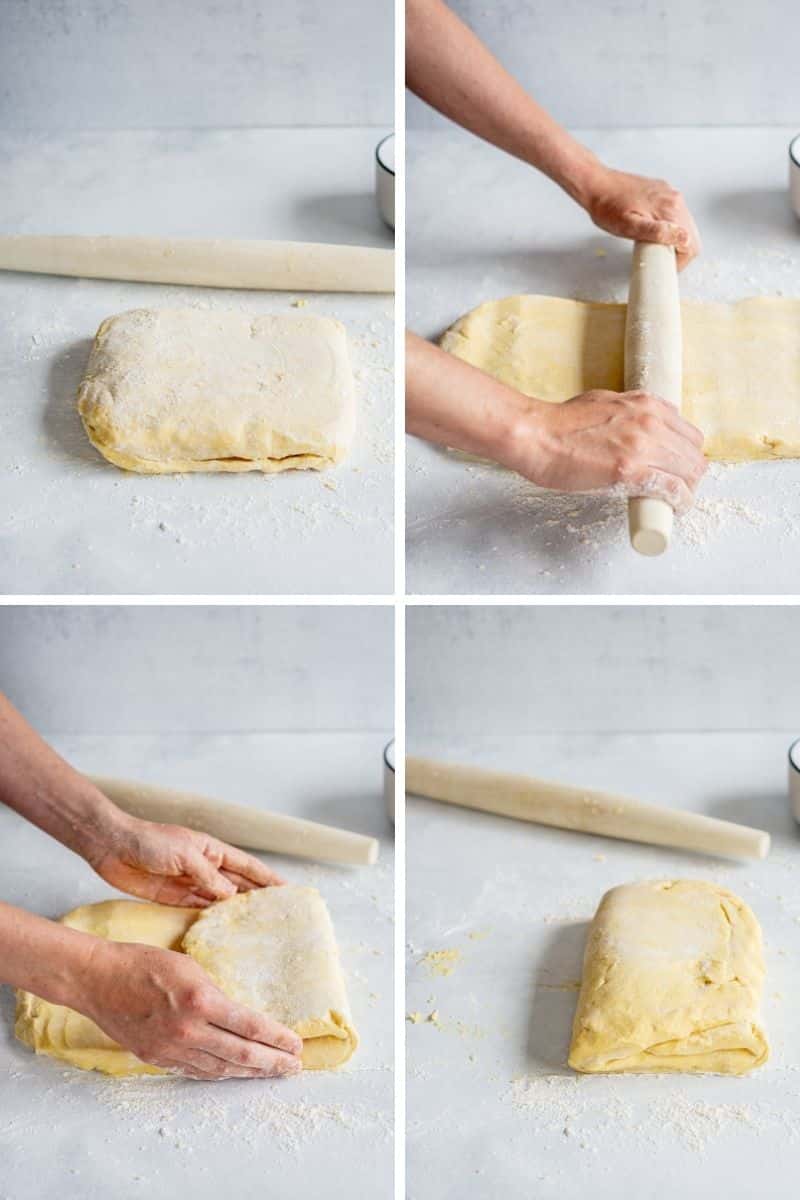
Folds 3&4
- Remove the dough from the fridge and place it vertically on a floured bench. Roll it into an 18×9 inches (45×22 cm) rectangle and fold. That was fold 3.
- Turn the dough 90 degrees and roll it back out into a rectangle and repeat the fold. That was fold 4.
- As the folds go on the dough will become smoother. For extra even layers, you can cut off the uneven edges of the dough rectangle. Wrap the dough up tightly and chill in the fridge for a minimum of 1 hour.
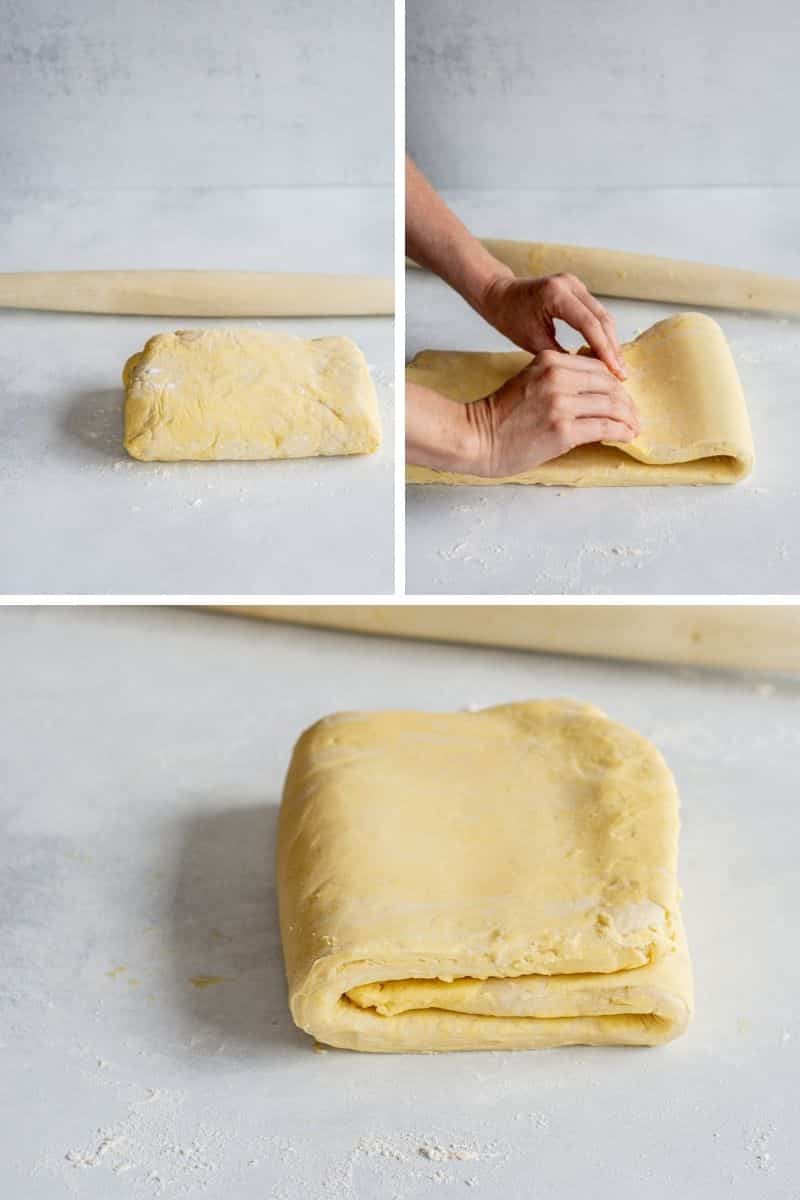
Fold 5 & 6
- Repeat the folding step twice more to complete fold 5 and fold 6.
- Wrap the dough up tightly and refrigerate for a minimum of 2 hours before using it.
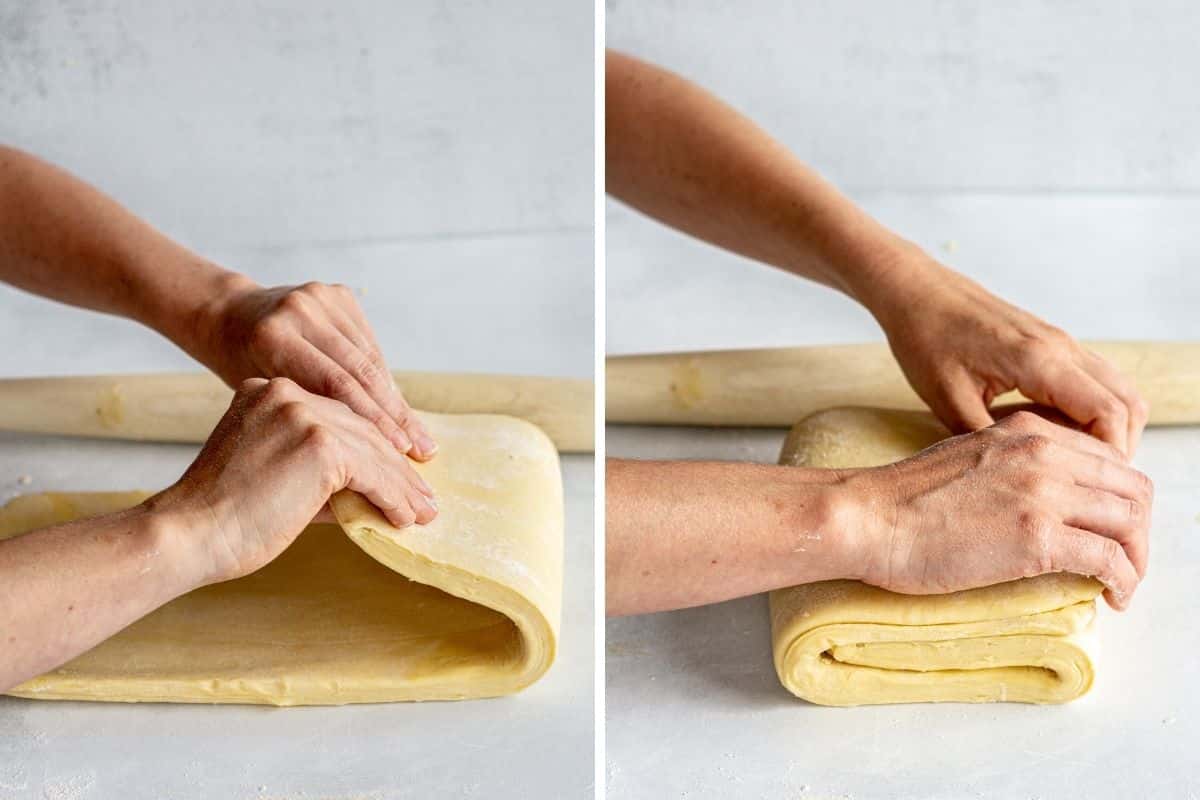
Freezing puff pastry
Freeze homemade puff pastry for up to 3 months. Prior to freezing it, cut the dough into portions so you only have to defrost what you need.
This recipe makes around 1.3kg puff pastry (depending on how much was cut off during lamination) which can be cut into 3 pieces of roughly 430g each.
Defrost the pastry in the fridge before rolling out. When rolling it out, place it upright, with the smooth side facing up. If you accidentally roll it out with the cut side facing up, you’ll ruin the lamination. Don’t knead, or squash the pastry or you’ll ruin the layers.
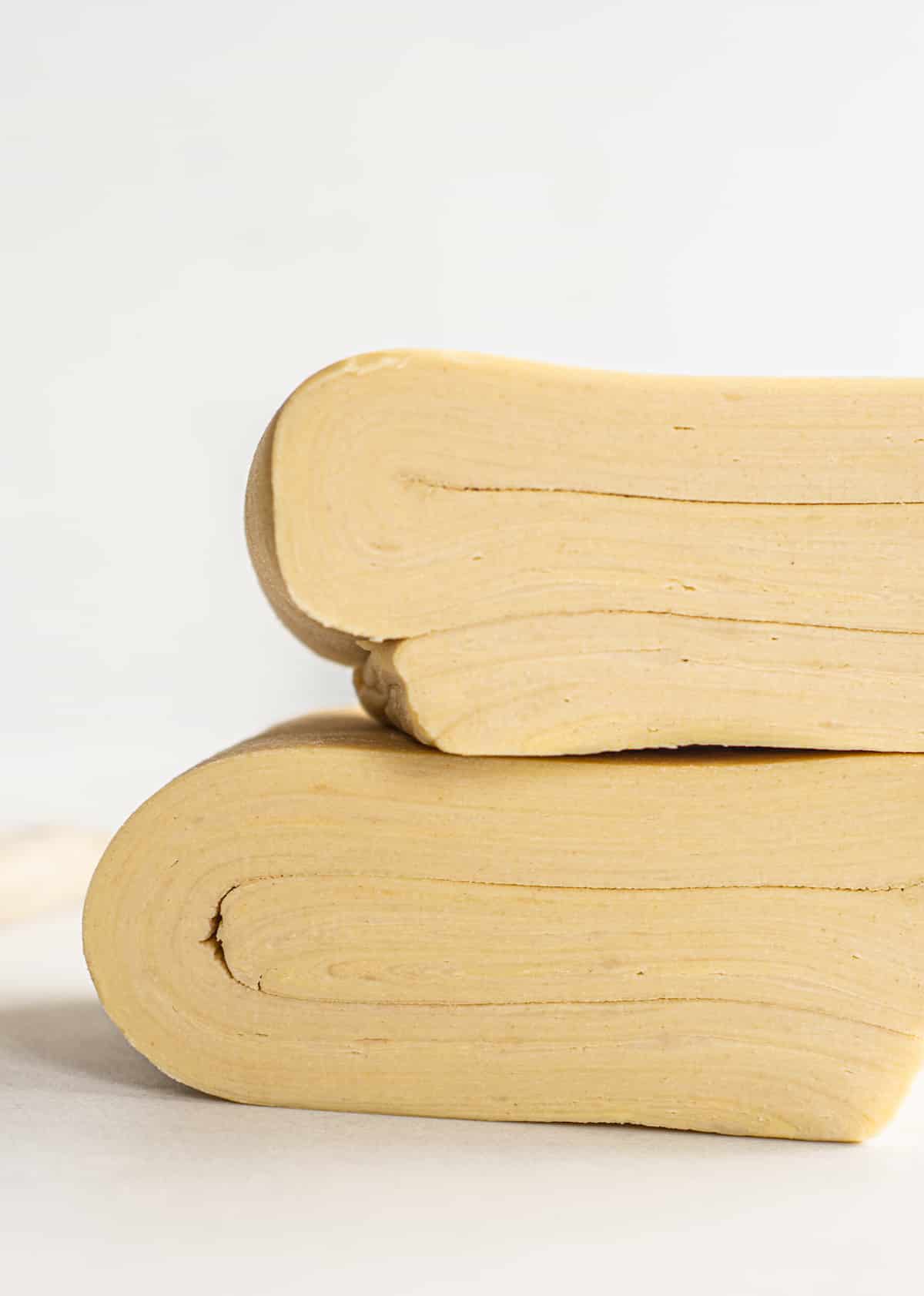
How thin to roll puff pastry
Roll the pastry portions out quite thin when using it, into a sheet of around ⅛inch (3-4mm) thickness. The cooking time and oven temperature for the pastry will depend on the recipe it is used in. Try in strawberry turnovers or puff pastry tomato tartlets!
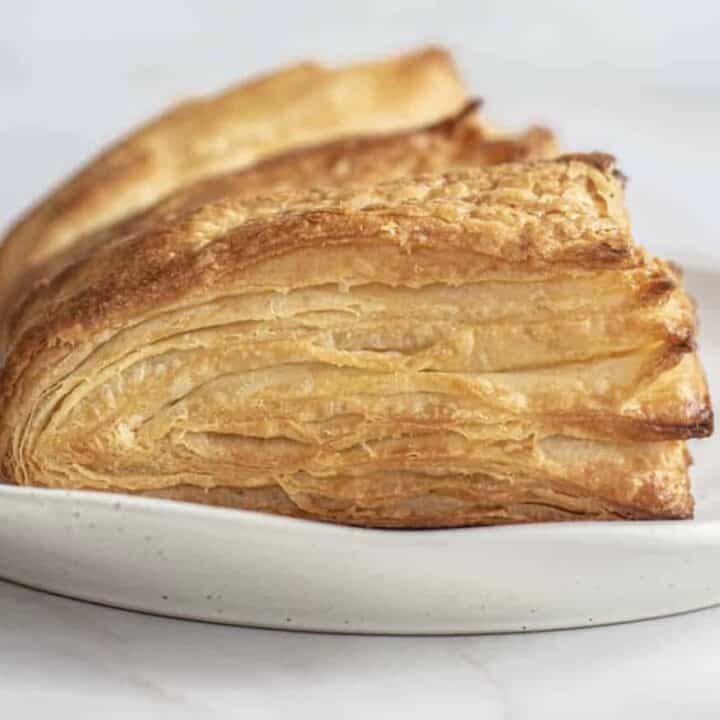
Inverted Puff Pastry
Inverted puff pastry is made by laminating the butter around the dough.It's extra light and flaky.
Ingredients
Dough
- 450g all-purpose flour
- 190ml water
- 100g unsalted butter, room temperature
- 1/2 Tbsp granulated sugar
- 1/2 Tbsp white vinegar or lemon juice
- 1 1/2 tsp salt
Butter packet
- 500g unsalted butter, room temperature
- 120g all-purpose flour
Instructions
The dough
- In a large bowl mix together the flour, water, butter, sugar, and salt into a rough dough. Tip the dough out onto a floured bench and knead it for around 5 minutes until smooth.
- Shape the dough into a 7x7inch (18x18cm) square. Wrap it up in parchment paper, cling wrap or place it in an airtight container and refrigerate it for 2 hours.
The butter packet
- Mix together the room temperature butter and flour for the butter packet until well incorporated. Spread the butter in between two sheets of parchment paper and roll it out into a 7x7inch (18x18cm) square.
- Chill this butter for around 20 minutes until cool but still pliable. If chilling for longer than this, remove the butter 10 minutes before the dough to ensure it's not too hard.
- The butter and the dough need to be similar consistencies. If the butter is too hard it will crack and shatter, and if it is too soft it will melt.
Laminating
- Remove the butter packet from the fridge and place it on a well-floured bench. Roll the butter out into a 14x8inch (36x20cm) rectangle. Use as much flour as you need to stop the butter from sticking to the rolling pin or the bench. Lift the butter up regularly as you roll it to ensure it isn't sticking to the bench.
- Place the dough at the bottom of the butter rectangle and fold the top of the butter over so it encases the dough. Now that the dough is tucked in, it's time to do the first set of folds.
- Roll the butter+dough out into a rectangle that's about 18x9 inches (45x22 cm). Focus on lengthening it, not widening it. Use dustings of flour as you need to, to ensure it rolls smoothly without sticking.
Fold 1 & 2
- Once it's in a rectangle, dust off any excess flour. Fold the top third of the rectangle down to the middle. Bring the bottom third over top. That was fold 1.
- Turn the dough 90 degrees and roll it back out into an 18x9 inches (45x22 cm) rectangle and repeat the fold. That was fold 2.
- Wrap the dough up tightly and chill in the fridge for a minimum of 1 hour.
Fold 3 & 4
- Remove the dough from the fridge and place it vertically on a floured bench. Roll it into an 18x9 inches (45x22 cm) rectangle and fold. That was fold 3.
- Turn the dough 90 degrees and roll it back out into a rectangle and repeat the fold. That was fold 4.
- As the folds go on the dough will become smoother. For extra even layers, you can cut off the uneven edges of the dough rectangle. Wrap the dough up tightly and chill in the fridge for a minimum of 1 hour.
Fold 5 &6
- Repeat the folding step twice more to complete fold 5 and fold 6.
- After the 6th fold, the dough can be wrapped up and refrigerated for a minimum of 2 hours before using it. It can also be frozen for when you need it.
Portioning puff pastry
- This recipe makes around 1.3kg puff pastry (depending on how much was cut off during lamination) which can be cut into 3 pieces of roughly 430g (15oz) each.
- Each 430g piece not being used right away can be wrapped up tightly and frozen for up to three months.
- Thaw in the refrigerator before rolling. When rolling it out, place it upright, with the smooth side facing up. If you accidentally roll it out with the cut side facing up, you'll ruin the lamination. Don't knead, or squash the pastry or you'll ruin the layers.
Cooking puff pastry
- The pastry portions should be rolled out quite thin when using it, into a sheet of around 1/8inch (3-4mm) thickness. The cooking time and oven temperature for the pastry will depend on the recipe it is used in.
Nutrition Information:
Yield: 20 Serving Size: 1Amount Per Serving: Calories: 320Total Fat: 25gSaturated Fat: 15gTrans Fat: 0gUnsaturated Fat: 8gCholesterol: 65mgSodium: 179mgCarbohydrates: 22gFiber: 1gSugar: 0gProtein: 3g
